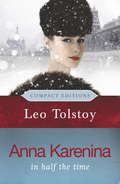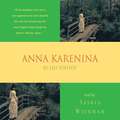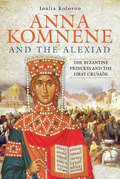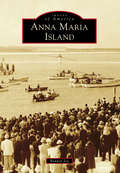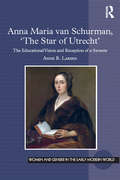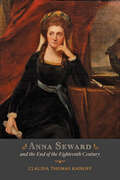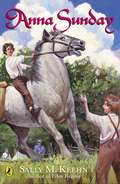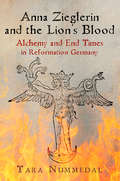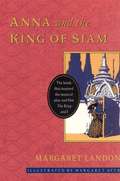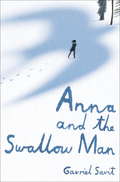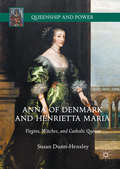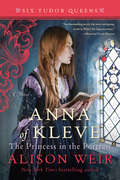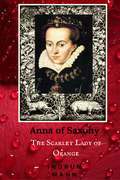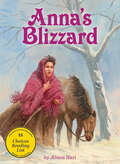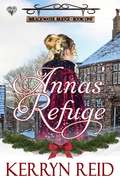- Table View
- List View
Anna Karenina
by Leo TolstoyAnna Karenina in half the timeAnna Karenina is the heart-wrenching tale of a woman who recklessly throws away everything she has for a passionate affair with a young soldier. Beautiful, popular, wife to a wealthy man and mother to an adored son, Anna seems to be in an enviable position.However, it takes only one encounter with Count Vronsky to fill her with the sense that her life has hitherto been empty. As the rest of the world fades into insignificance next to her great love, Anna faces an impossible choice¿
Anna Karenina
by Leo TolstoyRegarded by many as the world's greatest novel, this is the classic story of Anna Karenina, 'grande dame of Petersburg society', who forsakes everything - her marriage, her son and her position in society - for the dashing Count Vronksy, with tragic consequences.(P)1997 Hodder & Stoughton Audiobooks
Anna Karenina: Roman In 6 Büchern. - Primary Source Edition
by Leo TolstoyAnna Karenina in half the time Anna Karenina is the heart-wrenching tale of a woman who recklessly throws away everything she has for a passionate affair with a young soldier. Beautiful, popular, wife to a wealthy man and mother to an adored son, Anna seems to be in an enviable position. However, it takes only one encounter with Count Vronsky to fill her with the sense that her life has hitherto been empty. As the rest of the world fades into insignificance next to her great love, Anna faces an impossible choice¿
Anna Komnene and the Alexiad: The Byzantine Princess and the First Crusade
by Ioulia Kolovou&“Kolovou . . . rescues Anna from the talons of misogynist historians and places her where she belongs as an extraordinary, but very human, woman.&” —Beating Tsundoku A woman of extraordinary education and intellect, Anna Komnene was the only Byzantine female historian and one of the first and foremost historians in medieval Europe. Yet few people know of her and her extraordinary story. Subsequent historians and scholars have skewed the picture of Anna as an intellectual princess and powerful author. She has been largely viewed as an angry, bitter old woman, who greedily wanted a throne that did not belong to her. After being exiled to a convent, she composed the Alexiad, the history of the First Crusade and the Byzantine Emperor, Alexios I Komnenos (1081-1118), her father. This book aims to present Anna Komnene—the fascinating woman, pioneer intellectual, and charismatic author—to the general public. Drawing on the latest academic research to reconstruct Anna&’s life, personality and work, it moves away from the myth of Anna the conspirator and &“power-hungry woman&” which has been unfairly built around her over centuries of misrepresentation. It places Anna Komnene in the context of her own time: the ancient Greek colony and medieval Eastern Roman empire, known as Byzantium, with the magnificent city of Constantinople at its heart. At the forefront of an epic clash between East and West, this was a world renowned for its dazzling wealth, mystery and power games. This was a world with Anna Komnene directly at the center.&“Well-written, well-researched, and an overall fascinating read . . . A brilliant addition to women&’s history.&” —Where There&’s Ink There&’s Paper
Anna Madgigine Jai Kingsley: African Princess, Florida Slave, Plantation Slaveowner
by Daniel L. SchaferFlorida Historical Society Charlton Tebeau Award In this revised and expanded edition of Anna Kingsley’s remarkable life story, Daniel Schafer draws on new discoveries to prove true the longstanding rumors that Anna Madgigine Jai was originally a princess from the royal family of Jolof in Senegal. Captured from her homeland in 1806, she became first an American slave, later a slaveowner, and eventually a central figure in a free black community. Anna Kingsley’s story adds a dramatic chapter to the history of the South, the state of Florida, and the African diaspora.
Anna Maria Island (Images of America)
by Bonner JoyAnna Maria Island was once inhabited by Native Americans, but as the beauty became known to its first homesteader, George L. Bean, the island's destiny was to be a beacon to paradise. In spite of mangrove forests and throngs of mosquitoes, people came by boat to enjoy the white sand beaches and the turquoise waters of the Gulf of Mexico, with their cool onshore breezes and blazing sunsets. The Islander newspaper of the 1950s heralded, "Where life is good and the fishing is great." Anglers came from afar to test their skills against tarpon, the world's greatest game fish, and to hunt goliath grouper in the depths of Tampa Bay. Two modern bridges connected the island to the mainland in 1957, and with that the seven-mile-long island was on its way to becoming the jewel of Manatee County.
Anna Maria van Schurman, 'The Star of Utrecht': The Educational Vision and Reception of a Savante (Women and Gender in the Early Modern World)
by Anne R. LarsenDutch Golden Age scholar Anna Maria van Schurman was widely regarded throughout the seventeenth century as the most learned woman of her age. She was 'The Star of Utrecht','The Dutch Minerva','The Tenth Muse', 'a miracle of her sex', 'the incomparable Virgin', and 'the oracle of Utrecht'. As the first woman ever to attend a university, she was also the first to advocate, boldly, that women should be admitted into universities. A brilliant linguist, she mastered some fifteen languages. She was the first Dutch woman to seek publication of her correspondence. Her letters in several languages Hebrew, Greek, Latin, and French – to the intellectual men and women of her time reveal the breadth of her interests in theology, philosophy, medicine, literature, numismatics, painting, sculpture, embroidery, and instrumental music. This study addresses Van Schurman's transformative contribution to the seventeenth-century debate on women's education. It analyses, first, her educational philosophy; and, second, the transnational reception of her writings on women's education, particularly in France. Anne Larsen explores how, in advocating advanced learning for women, Van Schurman challenged the educational establishment of her day to allow women to study all the arts and the sciences. Her letters offer fascinating insights into the challenges that scholarly women faced in the early modern period when they sought to define themselves as intellectuals, writers, and thoughtful contributors to the social good.
Anna Maria's Gift
by Janice ShefelmanWhen Anna Maria's father, a famous violin maker, passes away, she is sent to live in the Pieta, an orphanage in Venice. Though she misses her father, she knows he will always be with her, as long as she has the beautiful violin that he crafted for her. Luckily, the Pieta is not just an orphanage-it's also a renowned music school whose teacher is none other than composer Antonio Vivaldi. When Anna Maria becomes his star pupil, another orphan's jealousy leads her to throw Anna Maria's precious violin into the canals. With help from her beloved teacher and new friends, Anna Maria searches Venice's bridges, streets, and canals, but it seems hopeless. Will Anna Maria ever find her father's violin? Can she ever be happy in Venice without it? This lyrical historical fiction story by Janice Shefelman perfectly captures the beauty of Venice, the joy of music, and how a bit of kindness can make a scary new place feel like home.
Anna Maria's Gift
by Robert Papp Janice ShefelmanReissued with a fresh look and added content, the Stepping Stones History series is kid-friendly and Common Core ready! When Anna Maria's father dies, she moves to an orphanage in Venice. Though she misses her father, she knows he will always be with her, as long as she has his beautiful violin. Luckily, the orphanage is also a renowned music school, with a teacher who is none other than composer Antonio Vivaldi. But when her violin is stolen, Anna Maria must search Venice's bridges, streets, and canals. Will she ever find it--and can she ever be happy in Venice without it? This lyrical historical-fiction story captures Venice, the joy of music, and how kindness can make a scary new place feel like home. History Stepping Stones now feature updated content that emphasizes Common Core and today's renewed interest in nonfiction. Perfect for home, school, and library bookshelves!
Anna Seward and the End of the Eighteenth Century
by Claudia T. KairoffA critical study of the prominent British poet’s work.Anna Seward and her career defy easy placement into the traditional periods of British literature. Raised to emulate the great poets John Milton and Alexander Pope, maturing in the Age of Sensibility, and publishing during the early Romantic era, Seward exemplifies the eighteenth-century transition from classical to Romantic. Claudia Thomas Kairoff’s excellent critical study offers fresh readings of Anna Seward's most important writings and firmly establishes the poet as a pivotal figure among late-century British writers.Reading Seward’s writing alongside recent scholarship on gendered conceptions of the poetic career, patriotism, provincial culture, sensibility, and the sonnet revival, Kairoff carefully reconsiders Seward's poetry and critical prose. Written as it was in the last decades of the eighteenth century, Seward’s work does not comfortably fit into the dominant models of Enlightenment-era verse or the tropes that characterize Romantic poetry. Rather than seeing this as an obstacle for understanding Seward’s writing within a particular literary style, Kairoff argues that this allows readers to see in Seward's works the eighteenth-century roots of Romantic-era poetry.Arguably the most prominent woman poet of her lifetime, Seward’s writings disappeared from popular and scholarly view shortly after her death. After nearly two hundred years of critical neglect, Seward is attracting renewed attention, and with this book Kairoff makes a strong and convincing case for including Anna Seward’s remarkable literary achievements among the most important of the late eighteenth century.“Professor Kairoff achieves her goal of providing “fresh readings, in a richer context,” which will go a long way toward reestablishing Seward’s importance. The book is a significant contribution to literary scholarship and will be widely read, cited, and admired.” —Paula R. Feldman“This lucid, stimulating study will challenge traditional notions not only of Seward but also of the interstice of Romanticism and late-century women authors.” —Choice“Kairoff effectively demonstrates the quality of Seward’s work, and articulates some of the ways in which a reappraisal of Seward might enrich our understanding of both eighteenth-century and Romantic-era literary cultures, and our conception of the writing practices of both male and female authors.” —Years Work in English Studies
Anna Sunday
by Sally M. KeehnAnna, disguised as a boy and accompanied by her younger brother Jed, leaves their Pennsylvania home and makes the difficult journey to join their wounded father in Winchester. Virginia, where they find themselves in danger from Confederate troops.
Anna Zieglerin and the Lion's Blood: Alchemy and End Times in Reformation Germany (Haney Foundation Series)
by Tara NummedalIn 1573, the alchemist Anna Zieglerin gave her patron, the Duke of Braunschweig-Wolfenbüttel, the recipe for an extraordinary substance she called the lion's blood. She claimed that this golden oil could stimulate the growth of plants, create gemstones, transform lead into the coveted philosophers' stone—and would serve a critical role in preparing for the Last Days. Boldly envisioning herself as a Protestant Virgin Mary, Anna proposed that the lion's blood, paired with her own body, could even generate life, repopulating and redeeming the corrupt world in its final moments.In Anna Zieglerin and the Lion's Blood, Tara Nummedal reconstructs the extraordinary career and historical afterlife of alchemist, courtier, and prophet Anna Zieglerin. She situates Anna's story within the wider frameworks of Reformation Germany's religious, political, and military battles; the rising influence of alchemy; the role of apocalyptic eschatology; and the position of women within these contexts. Together with her husband, the jester Heinrich Schombach, and their companion and fellow alchemist Philipp Sommering, Anna promised her patrons at the court of Wolfenbüttel spiritual salvation and material profit. But her compelling vision brought with it another, darker possibility: rather than granting her patrons wealth or redemption, Anna's alchemical gifts might instead lead to war, disgrace, and destruction. By 1575, three years after Anna's arrival at court, her enemies had succeeded in turning her from holy alchemist into poisoner and sorceress, culminating in Anna's arrest, torture, and public execution.In her own life, Anna was a master of self-fashioning; in the centuries since her death, her story has been continually refashioned, making her a fitting emblem for each new age. Interweaving the history of science, gender, religion, and politics, Nummedal recounts how one resourceful woman's alchemical schemes touched some of the most consequential matters in Reformation Germany.
Anna and Natalie
by Barbara H. ColeAnna is never picked to be on any team at school. But she is determined to be chosen when Mrs. Randall announces a letter-writing contest to decide which four students will be part of the wreath-laying team at the Tomb of the Unknown Soldier in Arlington, Virginia. This moving story of how Anna deals with her disability will touch the hearts of all readers as they cheer her on to the surprise ending.
Anna and Tranquillo: Catholic Anxiety and Jewish Protest in the Age of Revolutions
by Kenneth StowA historical interpretation of the diary of an eighteenth-century Jewish woman who resisted the efforts of the papal authorities to force her religious conversion After being seized by the papal police in Rome in May 1749, Anna del Monte, a Jew, kept a diary detailing her captors' efforts over the next thirteen days to force her conversion to Catholicism. Anna's powerful chronicle of her ordeal at the hands of authorities of the Roman Catholic Church, originally circulated by her brother Tranquillo in 1793, receives its first English-language translation along with an insightful interpretation by Kenneth Stow of the incident's legal and historical significance. Stow's analysis of Anna's dramatic story of prejudice, injustice, resistance, and survival during her two-week imprisonment in the Roman House of Converts--and her brother's later efforts to protest state-sanctioned, religion-based abuses--provides a detailed view of the separate forces on either side of the struggle between religious and civil law in the years just prior to the massive political and social upheavals in America and Europe.
Anna and the King of Siam
by Margaret LandonHistorical fiction about the young Welsh governess who changed the course of Siamese (Thai) history. The book that the play and film 'The King and I' were based on.
Anna and the King of Siam: The Book That Inspired The Musical And Film The King And I
by Margaret LandonBased on the incredible true story of one woman&’s journey to the exotic world of nineteenth-century Siam, the riveting novel that inspired The King and I. In 1862, recently widowed and with two small children to support, British schoolteacher Anna Leonowens agrees to serve as governess to the children of King Mongkut of Siam (present-day Thailand), unaware that her years in the royal palace will change not only her own life, but also the future of a nation. Her relationship with King Mongkut, famously portrayed by Yul Brynner in the classic film The King and I, is complicated from the start, pitting two headstrong personalities against each other: While the king favors tradition, Anna embraces change. As governess, Anna often finds herself at cross-purposes, marveling at the foreign customs, fascinating people, and striking landscape of the kingdom and its harems, while simultaneously trying to influence her pupils—especially young Prince Chulalongkorn—with her Western ideals and values. Years later, as king, this very influence leads Chulalongkorn to abolish slavery in Siam and introduce democratic reform based on the ideas of freedom and human dignity he first learned from his beloved tutor. This captivating novel brilliantly combines in-depth research—author Margaret Landon drew from Siamese court records and Anna&’s own writings—with richly imagined details to create a lush portrait of 1860s Siam. As a Rodgers & Hammerstein Broadway musical and an Academy Award–winning film, the story of Anna and the King of Siam has enchanted millions over the years. It is a gripping tale of cultural differences and shared humanity that invites readers into a vivid and sensory world populated by unforgettable characters.
Anna and the Swallow Man
by Gavriel Savit<p>A New York Times Bestseller. A Publishers Weekly Best Book of the Year. A Shelf Awareness Best Book of the Year. A Bulletin Blue Ribbon Book Winner of the Indies Choice Book Award. Winner of the Sydney Taylor Book Award. <p>A stunning, beautiful, and ambitious debut novel set in Poland during the Second World War perfect for readers of <i>All the Light We Cannot See</i> and <i>The Book Thief</i>. <p>Kraków, 1939. A million marching soldiers and a thousand barking dogs. This is no place to grow up. Anna Łania is just seven years old when the Germans take her father, a linguistics professor, during their purge of intellectuals in Poland. She’s alone. <p>And then Anna meets the Swallow Man. He is a mystery, strange and tall, a skilled deceiver with more than a little magic up his sleeve. And when the soldiers in the streets look at him, they see what he wants them to see. The Swallow Man is not Anna’s father—she knows that very well—but she also knows that, like her father, he’s in danger of being taken, and like her father, he has a gift for languages: Polish, Russian, German, Yiddish, even Bird. When he summons a bright, beautiful swallow down to his hand to stop her from crying, Anna is entranced. She follows him into the wilderness. <p>Over the course of their travels together, Anna and the Swallow Man will dodge bombs, tame soldiers, and even, despite their better judgment, make a friend. But in a world gone mad, everything can prove dangerous. Even the Swallow Man. <p>Destined to become a classic, Gavriel Savit’s stunning debut reveals life’s hardest lessons while celebrating its miraculous possibilities.
Anna in the Tropics
by Nilo CruzWinner of the 2003 Pulitizer Prize for Drama. . . there are many kinds of light.The light of fires. The light of stars.The light that reflects off rivers.Light that penetrates through cracks.Then there's the type of light that reflects off the skin.--Nilo Cruz, Anna in the TropicsThis lush romantic drama depicts a family of cigar makers whose loves and lives are played out against the backdrop of America in the midst of the Depression. Set in Ybor City (Tampa) in 1930, Cruz imagines the catalytic effect the arrival of a new "lector" (who reads Tolstoy's Anna Karenina to the workers as they toil in the cigar factory) has on a Cuban-American family. Cruz celebrates the search for identity in a new land."The words of Nilo Cruz waft from the stage like a scented breeze. They sparkle and prickle and swirl, enveloping those who listen in both specific place and time . . . and in timeless passions that touch us all. In Anna in the Tropics, the world premiere work he created for Coral Gables' intimate New Theatre, Cruz claims his place as a storyteller of intricate craftsmanship and poetic power."--Miami HeraldNilo Cruz is a young Cuban-American playwright whose work has been produced widely around the United States including the Public Theater (New York, NY), South Coast Repertory (Costa Mesa, CA), Magic Theatre (San Francisco, CA), Oregon Shakespeare Festival, McCarter Theater (Princeton, NJ) and New Theatre (Coral Gables, FL). His other plays include Night Train to Bolina, Two Sisters and a Piano, Hortensia and the Museum of Dreams, among others. Anna in the Tropics also won the Steinberg Award for Best New Play. Mr. Cruz teaches playwriting at Yale University and lives in New York City.
Anna of Byzantium
by Tracy BarrettAnna Comnena has every reason to feel entitled. She's a princess, her father's firstborn and his chosen successor. Someday she expects to sit on the throne and rule the vast Byzantine Empire. So the birth of a baby brother doesn't perturb her. Nor do the "barbarians" from foreign lands, who think only a son should ascend to power. Anna is as dismissive of them as are her father and his most trusted adviser--his mother, a manipulative woman with whom Anna studies the art of diplomacy. Anna relishes her lessons, proving adept at checkmating opponents in swift moves of mental chess. But as she matures into a young woman, her arrogance and intelligence threaten her grandmother. Anna will be no one's puppet. Almost overnight, Anna sees her dreams of power wrenched from her and bestowed on her little brother. Bitter at the betrayal, Anna waits to avenge herself, and to seize what is rightfully hers.From the Paperback edition.
Anna of Denmark and Henrietta Maria: Virgins, Witches, and Catholic Queens (Queenship and Power)
by Susan Dunn-HensleyThis book examines how early Stuart queens navigated their roles as political players and artistic patrons in a culture deeply conflicted about the legitimacy of female authority. Anna of Denmark and Henrietta Maria both employed powerful female archetypes such as Amazons and the Virgin Mary in court performances. Susan Dunn-Hensley analyzes how darker images of usurping, contaminating women, epitomized by the witch, often merged with these celebratory depictions. By tracing these competing representations through the Jacobean and Caroline periods, Dunn-Hensley peels back layers of misogyny from historical scholarship and points to rich new lines of inquiry. Few have written about Anna's religious beliefs, and comparing her Catholicism with Henrietta Maria's illuminates the ways in which both women were politically subversive. This book offers an important corrective to centuries of negative representation, and contributes to a fuller understanding of the role of queenship in the English Civil War and the fall of the Stuart monarchy.
Anna of Kleve, The Princess in the Portrait: A Novel (Six Tudor Queens)
by Alison WeirThe surprising and dramatic life of the least known of King Henry VIII’s wives is illuminated in the fourth volume in the Six Tudor Queens series—for fans of Philippa Gregory, Hilary Mantel, and The Crown. Newly widowed and the father of an infant son, Henry VIII realizes he must marry again to ensure the royal succession. Forty-six, overweight, and suffering from gout, Henry is soundly rejected by some of Europe's most eligible princesses. Anna of Kleve, from a small German duchy, is twenty-four, and has a secret she is desperate to keep hidden. Henry commissions her portrait from his court painter, who depicts her from the most flattering perspective. Entranced by the lovely image, Henry is bitterly surprised when Anna arrives in England and he sees her in the flesh. Some think her attractive, but Henry knows he can never love her. What follows is the fascinating story of an awkward royal union that somehow had to be terminated. Even as Henry begins to warm to his new wife and share her bed, his attention is captivated by one of her maids-of-honor. Will he accuse Anna of adultery as he did Queen Anne Boleyn, and send her to the scaffold? Or will he divorce her and send her home in disgrace? Alison Weir takes a fresh and astonishing look at this remarkable royal marriage by describing it from the point of view of Queen Anna, a young woman with hopes and dreams of her own, alone and fearing for her life in a royal court that rejected her almost from the day she set foot on England’s shore.
Anna of Saxony: The Scarlet Lady of Orange
by Ingrun MannSince her early youth at the glittering court of Dresden, Anna had been known as a difficult child and troublemaker. Servants complained about her violent outbursts, while courtiers bemoaned her general disregard for aristocratic female etiquette. Upon reaching her teenage years, the princess’ guardians decided that Saxony’s enfant terrible should leave home as quickly as possible by marrying a foreign suitor in a preferably far-away land. Enter William of Orange: handsome, charming, and heir to one of the Netherlands’ largest estates. The fact that he was also a profligate partier and lover of women was conveniently overlooked. Anna immediately fell for the Dutch bon vivant despite warnings from a few well-meaning relatives. For one, William was a Catholic, while Anna adhered to the Protestant teachings of Martin Luther, critical voices cautioned, correctly predicting future trouble for the princess in the Catholic Netherlands. Furthermore, the prince’s liege lord, the fanatical Philip II of Spain, very much disapproved of a match between his premier vassal and a “Lutheran heretic.” There was also the issue of plain Anna’s growing obsession with the roguish William; an obsession that was not reciprocated. In the end, the impetuous princess threw caution to the wind. No other than William would do for a husband, she insisted, while publicly announcing that “every vein in my body heartily loves him.”
Anna's Blizzard
by Alison HartWhen a fierce blizzard suddenly kicks up on a mild winter day, a young Nebraska girl must find the courage and strength to lead others to safety in this novel inspired by the true story of the 1888 School Children's Blizzard.Twelve-year-old Anna loves life on the Nebraska prairie where she lives with her parents and four-year-old brother in a simple sod house. She doesn't mind helping out with chores, especially when she is herding sheep with her beloved pony, Top Hat. On the open prairie, Anna feels at home. But at school she feels hopelessly out of place. Arithmetic is too hard, her penmanship is abysmal, and stuck-up Eloise Baxter always laughs at her mistakes.When a unexpected blizzard traps Anna, her schoolmates, and their young teacher in the one-room schoolhouse, Anna knows they must escape before it is too late. Does she have the courage and strength to lead her class through the whiteout to safety?Alison Hart offers young readers a dramatic story of rescue and survival featuring a plucky, determined protagonist. An author's note provides more information about prairie life in the late nineteenth century and about the School Children's Blizzard.
Anna's Refuge (Wrackwater Bridge #1)
by Kerryn ReidLewis Aubrey has grown up in the malignant shadow of his brother, Gideon. In London for the first time, with no thought of love, he is beguiled by Miss Anna Spain. Gideon steals her away, and then tosses her aside like a trampled rose. Months later, horrified to learn that Anna carries Gideon’s child, Lewis tracks her down amid the grit of industrial Leeds. He’s desperate to protect her—but can he survive marriage, believing she still yearns for his brother? Trusting and naïve, dreaming of a love that’s glorious and timeless, Anna falls for Gideon Aubrey and his lies. When he casts her aside in the middle of a ball, Lewis shields her from gossip. He becomes her rock in a world of anguish, and she grows to love him very much indeed. But what kind of woman would condemn a man to a marriage he cannot possibly want, raising a child not his own? Somehow, these two tattered souls must escape Gideon’s shadow and find their way to happiness, for the child’s sake…and for their own.
Anna's Story (Anna's Story Ser.)
by Rich McKayAn immigrant woman reflects on her past in Germany before, during, and after World War II, as well as finding love, family, and a future in America. This is the remarkable life story of Anna Burkardt McKay, who was born in Germany before WWII and who moved to the United States as an American war bride in 1947 to raise a family on a small cattle ranch in Nevada. Through a childhood in Hochst, Germany, where fond memories mingle with remembrances of the horrors of the Second World War&’s beginning; into a young adulthood, filled with terrors of the escape and evasion of Nazi youth work camps; through falling in love and immigrating to the United States to marry, and later have a family, this is Anna&’s Story.
